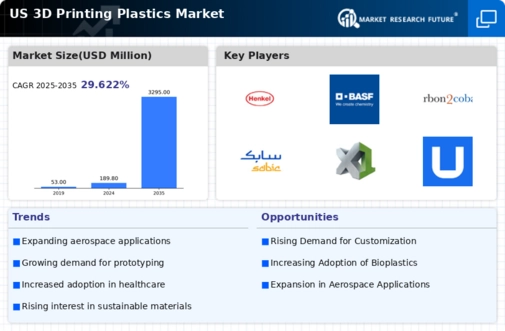The 3D printing plastics market is characterized by a dynamic competitive landscape, driven by technological advancements and increasing demand across various sectors, including aerospace, automotive, and healthcare. Key players such as Stratasys (US), 3D Systems (US), and HP Inc. (US) are at the forefront, each adopting distinct strategies to enhance their market positioning. Stratasys (US) focuses on innovation through continuous product development, particularly in materials that enhance performance and sustainability. Meanwhile, 3D Systems (US) emphasizes strategic partnerships to expand its service offerings and market reach, while HP Inc. (US) leverages its expertise in digital printing to integrate 3D printing solutions into its existing portfolio, thereby enhancing operational efficiencies.
The competitive structure of the market appears moderately fragmented, with several players vying for market share. Key tactics such as localizing manufacturing and optimizing supply chains are increasingly prevalent, as companies seek to reduce costs and improve delivery times. This collective approach not only enhances operational efficiency but also fosters a more resilient supply chain, which is crucial in the current economic climate.
In November 2025, Stratasys (US) announced a partnership with a leading aerospace manufacturer to develop advanced composite materials for 3D printing applications. This collaboration is poised to enhance Stratasys's capabilities in producing lightweight, high-strength components, which are essential for the aerospace sector. The strategic importance of this partnership lies in its potential to position Stratasys as a key player in the aerospace supply chain, thereby driving revenue growth and market share.
In October 2025, 3D Systems (US) launched a new line of bio-compatible materials aimed at the healthcare sector, specifically for surgical applications. This move is significant as it not only diversifies 3D Systems's product offerings but also aligns with the growing trend towards personalized medicine. By focusing on bio-compatible materials, the company is likely to capture a larger share of the healthcare market, which is increasingly adopting 3D printing technologies for patient-specific solutions.
In September 2025, HP Inc. (US) unveiled a new 3D printing platform that integrates AI-driven analytics to optimize production processes. This innovation is indicative of the broader trend towards digitalization within the industry, as companies seek to leverage data to enhance operational efficiencies. The integration of AI into 3D printing processes could significantly reduce waste and improve product quality, thereby providing HP with a competitive edge in the market.
As of December 2025, the competitive trends in the 3D printing plastics market are increasingly defined by digitalization, sustainability, and the integration of AI technologies. Strategic alliances are shaping the landscape, enabling companies to pool resources and expertise to drive innovation. Looking ahead, it is anticipated that competitive differentiation will evolve, with a shift from price-based competition to a focus on technological innovation and supply chain reliability. This transition underscores the importance of adaptability and forward-thinking strategies in maintaining a competitive advantage.





















Leave a Comment